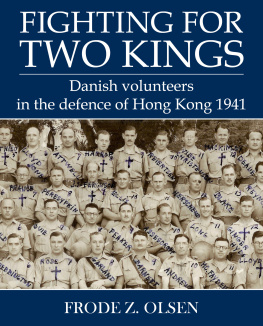

Fighting for Two Kings
by Frode Z. Olsen
First published 2010 in Danish as Ikke en jordisk chance, Danske frivillige i forsvar af Hong Kong 1941 by Turbine Forlaget, Denmark. Translated from Danish by Karen Bek-Pedersen
ISBN: 978-988-8552-57-3
2019 Earnshaw Books
HISTORY / Asia / China
EB125
All rights reserved. No part of this book may be reproduced in material form, by any means, whether graphic, electronic, mechanical or other, including photocopying or information storage, in whole or in part. May not be used to prepare other publications without written permission from the publisher except in the case of brief quotations embodied in critical articles or reviews. For information contact info@earnshawbooks.com
Published by Earnshaw Books Ltd. (Hong Kong)
Generous support from S. C. Van Fonden has made it possible to translate and publish this work in English, for which the author and the publisher are deeply grateful.

Went the day well?
We died and never knew.
But, well or ill,
Freedom, we died for you.
John Maxwell Edmonds
Historical dates
1931 |
September 18: | Japan attacks and occupies the northern Chinese province of Manchuria |
1936 |
November 25: | Germany and Japan sign the Anti-Comintern Pact directed against the Soviet Union and communism |
1937 |
July 7: | Japan expands its war efforts against China with the so-called Marco Polo Bridge Incident and the war escalates from there |
August 12: | Japan attacks Shanghai |
December: | Japan attacks Nanjing |
1938 |
March 11: | Germany annexes Austria into the Third Reich (Anschlu) |
October 21: | The important port of Canton close to Hong Kong is occupied by the Japanese |
1939 |
May 31: | Denmark and Germany sign a non-aggression pact |
August 23: | The Soviet Union and Germany sign a non-aggression pact |
September 1 3: | Germany attacks Poland. Britain declares war against Germany. World War Two is a reality |
September 17: | The Soviet Union invades Poland from the east |
November 30: | The Soviet Union attacks Finland; a peace agreement is signed in March 1940 |
1940 |
April 9: | Denmark occupied by Germany |
May 10: | Germany attacks the Netherlands, Belgium and Luxembourg |
June 12: | Germany attacks France, which surrenders after 10 days |
July 10: | Germany initiates air raids on major English cities; the bombardments continue into the spring of 1941 |
September 22: | Japan invades French Indochina |
September 27: | Germany, Italy and Japan enter an agreement of mutual assistance |
1941 |
June 22: | Germany attacks the Soviet Union |
December 8: | Japan attacks Hong Kong, Malaysia, Singapore, the Philippines and the American naval base of Pearl Harbor in Hawaii. The US declares war against Germany. The Axis Powers declare war against the US |
1942 |
June 4 7: | The Battle of Midway; the fortunes of war turn against Japan |
1943 |
February: | The Battle of Stalingrad; the fortunes of war turn against Germany |
1944 |
January 22: | Allied Forces land in Italy |
June 6: | British and American troops land on the coast of Normandy |
December: | Most of France, Belgium and the Netherlands are liberated |
1945 |
March: | Allied troops cross the border into Germany |
May 4 9: | Denmark is liberated; Germany surrenders to the Allied Powers |
May: | Allied Forces occupy the Japanese island of Okinawa |
August 6 and 9: | The U.S. drops nuclear bombs onto Hiroshima and Nagasaki |
August 15: | Japan surrenders to the Allied Powers; World War Two ends |
Note on names
Past and current names of countries, areas and cities
British Malaya Malaysia and Singapore
Dutch East Indies Indonesia
French Indo-China Vietnam, Cambodia and Myanmar
Formosa Taiwan
Peking Beijing
Nanking Nanjing
Chungking Chongqing
Tientsin Tianjin
Tsingtao Qingdao
Waichow Huizhou
Rangoon Yangon
Danish names and letters
In addition to the 26 letters of the English alphabet, the Danish alphabet contains three other letters:
, transcribed as ae or a, pronounced similar to e in ever
, transcribed as oe or o, pronounced similar to i in bird or e in nerd
, transcribed as aa or a, pronounced similar to a in also or o in oak.
The original Danish spelling of names has been maintained for the sake of authencitiy.
Preface
The letters of the alphabet are as patient as angels. They wait day after day, year after year, just to be seen, read and understood.
Three lines, eight words and a few numbers sparked this account. Sharply and elegantly engraved, they decorate a marble plaque, which sits above the basin of a drinking fountain in a Copenhagen schoolyard. Spring, summer, autumn and winter, thousands of children have looked at them on their way to class or as they tilted their heads and let their eyes wander while water ran in through a corner of their mouths. One day when they have learned to read, they will understand that these lines convey information about former students who gave their lives in the struggle for freedom during World War Two. Some of the children will notice that these students all died young, on the threshold of realising their dreams and hopes in life.
As a child, I looked at the names countless times, imagined a few vague scenes and then ran off back into my own life again.
One spring day in 2012, many years later, I returned to my old school and stopped by the plaque. It looked the same, but then again perhaps not. I had never before finished reading every last name on the plaque, and for the first time, I noticed the name of a young man who had died close to Christmas in 1941 as a member of the Hong Kong Volunteer Defence Corps.
Who was he? What had taken him so far away from home and into a foreign volunteer defence corps? Hong Kong in December 1941 what happened out there that a Danish person should die for?














